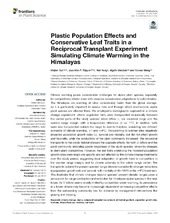| dc.contributor.author | Cui, Haijun | |
| dc.contributor.author | Töpper, Joachim Paul | |
| dc.contributor.author | Yang, Yan | |
| dc.contributor.author | Vandvik, Vigdis | |
| dc.contributor.author | Wang, Genxu | |
| dc.date.accessioned | 2019-02-26T16:18:44Z | |
| dc.date.available | 2019-02-26T16:18:44Z | |
| dc.date.issued | 2018-07-30 | |
| dc.Published | Cui, Töpper J, Yang Y, Vandvik V, Wang G. Plastic Population Effects and Conservative Leaf Traits in a Reciprocal Transplant Experiment Simulating Climate Warming in the Himalayas. Frontiers in Plant Science. 2018:9:1069 | eng |
| dc.identifier.issn | 1664-462X | en_US |
| dc.identifier.uri | https://hdl.handle.net/1956/19150 | |
| dc.description.abstract | Climate warming poses considerable challenges for alpine plant species, especially for competitively inferior ones with resource-conservative adaptations to cold climates. The Himalayas are warming at rates considerably faster than the global average, so it is particularly important to assess how and through which mechanisms alpine plant species are affected there. We employed a demographic approach in a climate change experiment, where vegetation turfs were transplanted reciprocally between the central parts of the study species’ (Viola biflora L. var. rockiana) range and the warmer range margin, with a temperature difference of ca. 1°C. In addition, turfs were also transplanted outside the range to warmer habitats, simulating two different scenarios of climate warming, +1 and +4°C. Transplanting to warmer sites negatively impacted population growth rates (λ), survival and clonality, but did not affect growth and fecundity, while the productivity of the plant community increased. The reciprocal transplants to the colder habitat showed the opposite effects, for both V. biflora and the plant community, indicating plastic responses of the study species, driven by changes in plant–plant competition. However, the leaf traits underlying the modeled population growth rates were origin-site specific and not affected by the climate-change treatments over the study period, suggesting local adaptation of growth form to competition in the warmer range margin, and to climate adversity in the colder range center. The transplants outside the present species’ range showed consistently stronger reductions in population growth rate and survival, with mortality of 90–100% in the +4°C treatment. This illustrates that climatic changes beyond species’ present climatic ranges pose a serious risk for range contraction and extinction for Himalayan alpine species in the near future. As V. biflora seems mostly limited by competition under warming, its persistence in a future climate may become increasingly dependent on keeping competitive effects from the surrounding community low, for instance by management interventions like grazing and mowing. | en_US |
| dc.language.iso | eng | eng |
| dc.publisher | Frontiers Media | en_US |
| dc.rights | Attribution CC BY | eng |
| dc.rights.uri | http://creativecommons.org/licenses/by/4.0/ | eng |
| dc.subject | Climate change | eng |
| dc.subject | Alpine | eng |
| dc.subject | reciprocal transplant experiment | eng |
| dc.subject | altitudinal gradient | eng |
| dc.subject | population growth rate | eng |
| dc.subject | vital rate | eng |
| dc.subject | Viola biflora var. rockiana | eng |
| dc.subject | leaf traits | eng |
| dc.title | Plastic Population Effects and Conservative Leaf Traits in a Reciprocal Transplant Experiment Simulating Climate Warming in the Himalayas | en_US |
| dc.type | Peer reviewed | |
| dc.type | Journal article | |
| dc.date.updated | 2018-09-05T10:02:53Z | |
| dc.description.version | publishedVersion | en_US |
| dc.rights.holder | Copyright 2018 The Authors | en_US |
| dc.identifier.doi | https://doi.org/10.3389/fpls.2018.01069 | |
| dc.identifier.cristin | 1606869 | |
| dc.source.journal | Frontiers in Plant Science | |
| dc.relation.project | Andre: Norwegian Center for International Cooperation in Education | |
| dc.subject.nsi | VDP::Matematikk og naturvitenskap: 400::Zoologiske og botaniske fag: 480 | |
| dc.subject.nsi | VDP::Mathematics and natural scienses: 400::Zoology and botany: 480 | |

